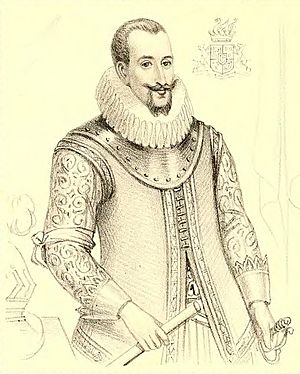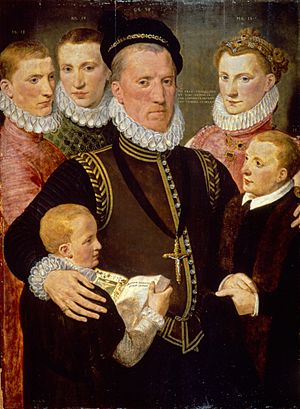Robert Seton, 1st Earl of Winton facts for kids
Quick facts for kids
Robert Seton, 1st Earl of Winton
|
|
|---|---|
 |
|
| 1st Earl of Winton | |
| In office 1600–1603 |
|
| Personal details | |
| Born | 1553 |
| Died | 22 March 1603 |
| Spouse | Margaret Montgomerie |
| Children | 6, including Robert, George, and Alexander |
| Parents | George Seton, 7th Lord Seton and Isabel Hamilton |
Robert Seton, 1st Earl of Winton (1553 – 22 March 1603) was an important Scottish nobleman. He was the first person to hold the title of Earl of Winton. Robert was a very loyal supporter of Mary, Queen of Scots, who was the queen of Scotland.
Contents
Robert Seton's Early Life

Robert Seton was the son of George Seton, 7th Lord Seton. From a young age, he was involved in his father's work and in important matters of the country. He studied in France when he was young. He even went with his father on trips to France when his father was an ambassador for Mary, Queen of Scots. Robert grew up as a close friend of Queen Mary's son, who later became King James VI.
Helping the Royal Family
Like his father, Robert was very dedicated to the Queen and the House of Stuart royal family. He was part of the group that helped Queen Mary escape from Lochleven Castle. He also took part in the battle of Langside in 1568.
Rescuing King James VI
Later, Robert was one of the people who helped King James VI get away from the powerful Douglas family. He continued to support the King during difficult times. This included events like the Gowrie conspiracy, where people tried to cause trouble for the King.
Managing His Estates
When his father passed away in 1586, Robert became the 8th Lord Seton. His father had spent a lot of money on trips as an ambassador. He also lost money by supporting the Queen. However, Robert was very smart and careful with his money. He quickly made his family's finances strong again. He made sure his children had good futures.
Seton Palace and Royal Guests
Robert was known for being very welcoming at Seton Palace. The King and Queen often visited there. Important visitors and ambassadors from other countries were also entertained grandly. In 1594, Robert was in charge of the King's household at the party for Prince Henry's baptism. This event took place at Stirling Castle.
Improving His Property
Robert worked hard to make his lands better. He especially improved the old harbor at Cockenzie. This was a fishing village on the Firth of Forth. He made the harbor bigger so larger ships could use it. In 1599, the King officially made Cockenzie a free port and a special town. Robert was a favorite of King James VI. Because of this, he was given the new title of Earl of Winton in 1600.
His Strong Faith
Robert Seton was a very strict Roman Catholic. At that time, there were often disagreements between Catholics and Protestants in Scotland. The local Presbytery (a group of Protestant church leaders) in Haddington, East Lothian caused problems for Robert and his family.
Seton Church
One record shows that in 1597, the Presbytery asked Lord Seton if they could use Seton Church for a few days. They wanted to visit all the churches in their area. But Robert completely said no. Protestant church services have never been held in Seton Church. After the Seton family changed their religion later, they went to the church in Tranent. Their own church at Seton was left empty and has been ever since.
Family Life
In 1582, Lord Seton married Lady Margaret Montgomerie. She was the oldest daughter of Hugh Montgomerie, 3rd Earl of Eglinton. Robert and Margaret had five sons and one daughter:
- Robert Seton, 2nd Earl of Winton
- George Seton, 3rd Earl of Winton
- Sir Alexander Seton of Foulstruther, who later became the 6th Earl of Eglinton.
- Sir Thomas Seton of Olivestob
- Sir John Seton of St. Germains
- Lady Isabel Seton
His Death and Burial
Robert Seton, 1st Earl of Winton, passed away on March 22, 1603. In his last will, he wrote that he wanted to be buried quietly and respectfully. He wished to be buried in his College Church of Seton, where his ancestors were buried. He specifically mentioned "unlawful ceremony." This likely meant he did not want any Protestant church services at his funeral, as he was a strong Catholic.
He was buried on April 5, 1603. On the very same day, King James VI of Scotland left Edinburgh to travel to London. He was going to become King James I of England. The King's group waited at the orchard of Seton Palace. They waited until Robert Seton's funeral was over. This was so that the people mourning Robert would not leave the funeral to follow the King.

